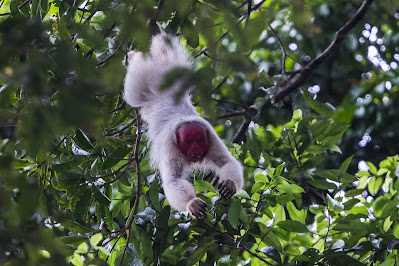 |
| Cacajao amuna Silva, Amaral, Roos, Bowler, Röhe, Sampaio, Janiak, Bertuo, Santana, Souza Silva, Rylands, Gubili, Hrbek & Boubli, 2022 |
 |
| Cacajao amuna Kanamari White Uakari |
Highlights
• We revised the taxonomic classification of bald-headed uakaris, genus Cacajao.
• The use of a single mitochondrial marker did not recover the shallower relationships.
• ddRADseq phylogenetic analyses retrieved five lineages of bald-headed uakaris.
• We proposed a taxonomic arrangement with five species of bald-headed uakaris.
• A new species is described based on molecular and morphological information.
Abstract
Bald uakaris, genus Cacajao, are Amazonian primates currently classified as one species and four subspecies based on the patterns of pelage coloration. In this study, we test if their current taxonomy is represented by the phylogenetic relationship of the main lineages retrieved from molecular data. We included, for the first time, all bald uakari taxa in a mitochondrial (cytochrome b) and genome-wide (ddRAD) phylogenetic analyses. We also examined the pattern of pelage colouration in specimens from zoological collections. Having determined the number of lineages using Maximum Likelihood and the species tree using coalescent analyses, we test their divergence time using a Bayesian approach. While the cytochrome b analysis only recovered two clades, the ddRAD analysis supported the reciprocal monophyly of five lineages of bald uakaris, with all clades including only individuals with distinct and exclusive diagnostic phenotypic characters. We found that species diversification in Cacajao occurred during the last 300 Kya and may have been influenced by the formation of rivers and flooded forests in western Amazonia. We propose that the four bald uakari subspecies currently recognised can be upgraded to species level and we describe the white uakaris from the basin of the Rio Tarauacá as a new species.
Keywords: Amazon rainforest, Neotropical primates, Phylogenetic Species Concept, Pitheciinae, species delimitation
Cacajao calvus (I. Geoffroy Saint-Hilaire, 1847) – White Bald Uakari
Cacajao rubicundus (I. Geoffroy Saint-Hilaire and Deville, 1848) – Red Bald Uakari
Cacajao ucayalii Thomas, 1928 – Ucayali Bald Uakari
Cacajao novaesi Hershkovitz, 1987 – Novaes’ Bald Uakari
Cacajao amuna sp. n.
Etymology: The new species is named in tribute to the Amuna-dyapas, a Kanamari subgroup of the Kanamaris do Rio Juruá Indigenous Territory (TI Kanamaris do Rio Juruá), on the right bank of the Rio Taraucá. “Amuna” is a Katukina vocative that means “uakari monkey”. We suggest the common name “the Kanamari White Uakari”.
Felipe Ennes Silva, João Valsecchi do Amaral, Christian Roos, Mark Bowler, Fabio Röhe, Ricardo Sampaio, Mareike Cora Janiak, Fabrício Bertuol, Marcelo Ismar Santana, José de Souza Silva Júnior, Anthony B. Rylands, Chrysoula Gubili, Tomas Hrbek, Allan D. McDevitt and Jean P. Boubli. 2022. Molecular Phylogeny and Systematics of Bald Uakaris, Genus Cacajao Lesson, 1840 (Primates: Pitheciidae), with the Description of A New Species. Molecular Phylogenetics and Evolution. In Press, 107509. DOI: 10.1016/j.ympev.2022.107509




